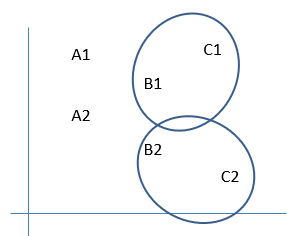 07.Geospatial(W10&11)
07.Geospatial(W10&11)
10/19/23About 2 min
Geospatial questions
| Spatial Question | Description |
|---|---|
| Location (identify) | What exist at specific location? What object is located at 49N 123W? |
| Condition (search) | Where can you find specific conditions? where do low income residents live? |
| Trends (overlay analysis) | What has changed over time? What is the change in green area size from 2000? |
| Routing (network analysis) | Which is the best way to travel? How can I reach a destination in the least time? |
| Patterns (Query analysis) | How are object distributed in geographic space? Does salmon streams affect bear presence? |
| Modeling (building spatial models) | How would conditions change in the future? What areas will be floored by 1m sea level rise? |
Spatial Queries
- Spatial Range Queries
- Find all cities within 50 miles of Paris
- Query has associated region (location, boundary)
- Answer includes overlapping or contained data regions
- Nearest-Neighbor Queries
- Find the 10 cities nearest to Paris
- Results must be ordered by proximity
- Spatial Join Queries
- Find all cities near a lake
- Join condition involves regions and proximity.
Spatial Data Mining
Spatial Data Mining: the extraction of spatial patterns from both spatial and aspatial data, possibly stored in a spatial database
Spatial Pattern: a pattern showing the interaction of two or more spatial objects or space-depending attributes according to a particular spacing or set of arrangements
Families of Spatial Data Mining Patterns
Hot Spot:
- Which locations are unusual or share commonalities?
Info
K-Means cannot work. DBScan works.
Spatial Interactions
- Co-location objects
- Which subset of spatial phenomena interact?
Info
Association rules cannot work. Spatial Association Rule (Han, 1995) works.
Spatial Association Rule (Han, 1995)

Input: Feature A, B, C
Instances: A1, A2, B1, B2, C1, C2- Create transactions by reference feature, e.g. C
(C1, B1)
(C2, B2) - Support (A, B) = 0
Support(B, C)= 2/2 = 1 - Output = (B, C)
Spatial Colocation

Feature: A, B, C
Feature Instances: A1, A2, B1, B2, C1, C2
Feature subsets: (A, B), (A, C), (B, C), (A, B, C)- Participation ratio(Pr):
Pr(A, (A, B))= fraction of A instances neighbouring feature {B} = 2/2 = 1
Pr(B, (A, B)) = ½ - Participation index (A, B) = pi(A, B) = min{pr(A, (A,B)), pr(B, (A,B)) = min {1, ½} = ½
Pi(B, C) = min{pr(B, (B,C)), pr(C, (B,C))} = min {1,1,}=1 - Output: (A, B), (B,C)
Location Prediction
- Where will a phenomenon occur?
Info
Regression cannot work
